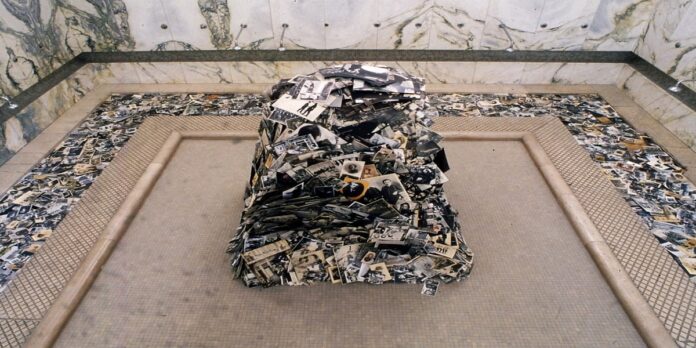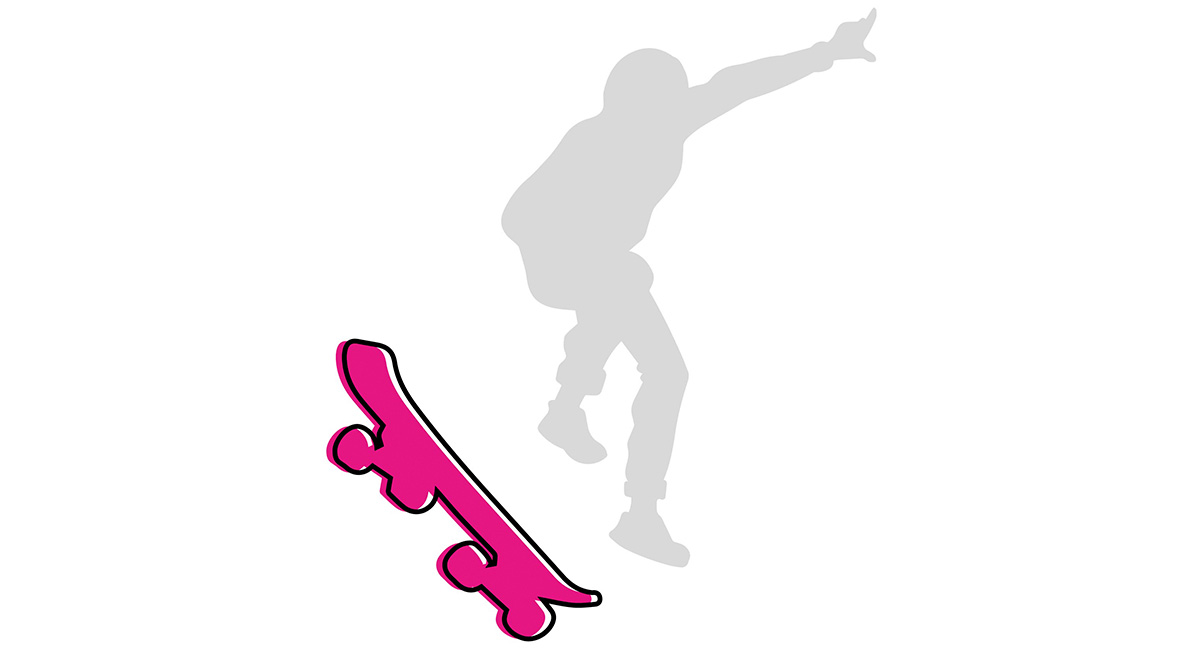“e fu per sempre”.
Eugenio Montale
“Death continuously cuts a simulacrum of a meaning against a simulacrum of non sense (the world, nature)”. I have chosen these words to introduce the other two very important themes treated in the Fabio Mauri’s book that represents the best of his writings. To me they are tied to the last sentence I quoted to clarify his position about the value of individual ideology of anybody interested in becoming an artist …, “for those who are seized by art, by serious art”.
Art is therefore a disease that endlessly deals with death, one’s own and that of those you love. I recommend to carefully read the “Six cobalt reflections” in Blu cobalto (pages 168-169). I refer to anyone who wants to get a little closer to his thought, which is made up of words at least as much as of images: “An expression is a very dense experience .. death is a catharsis, be it a religious or a non religious one, it doesn’t matter, and it can sum up everything.
The only thing that it is not is that it is not secular, it is not so much confident in the world “(because it is committed to on building the Dome or “cupola”). Incisive disconcerting and unsettling words of incisiveness. Artists have a precise consciousness of death, even those who practice the strategy of the moment, of immanence: “If you can’t live now in this place, at this very moment, when and where could you ever do it?” (it a quote engraved on a Zen temple).
I still apologize for sinking my hands at random, here and there, in this book: others will be able to do it, and lawfully, in their own way. My choices are really personal: when you try to understand the poetics of a great artist, you can easily make mistakes, especially if you are, you too, “serious” towards such vocation. Later I will be frank about my even clear distinctions; but right now I am anxious because I intend to avoid to betray his thoughts. Please, listen to his voice again: “let’s imagine that memory, possibly coming from the Chaos and the Void, exhibits itself as the supreme faculty of Consistency and Composition of Sense”.
Also, alongside this statement, here you are a more precise explication regarding making art: “Is language a stone? According to the perception’s laws, such thought seems to be close to the propositional self-loyalty of the Sense”. Propositional is a very important word and must be eliminated from any easy misunderstandings: “Against the poisoned ideology, an ideology as a criticism arises again, as an effective weapon”.
An articulated awareness of this, of the past (memory is here again); the judgment of ethical stamp as a category of conceptual – or at least psychological – support of the aesthetic itself”. But, when already almost eighty, he wrote: “I do not know if it is memory: I perceive memory as something not different from a pure actuality of the mind … In my mind I measure a present with the present.”
But the present of the poet is pain: “As long as pain exists in the world, poetry will exist” (I quote this statement by Eugenio Montale because I want to detach myself a little from Mauri-thought). From here, you can start to re-emerge after having plunged yourself into a sea full of always precise concepts whose accuracy derives better from their random juxtaposition than from a rigorous discourse. I wonder: can pain (I know something about it) be overcome, blocked, or even temporarily forgotten, thanks to art? Can there be a catharsis? I mean the moral pain, of course, the one from which he started in the so far distant post-war years in order to look for a liberation into art, with art. This is the main challenge, it is an important and decisive issue.
If you are an artist you have to answer a question like that. Sometimes the rationalization, which insists in every poetics – let alone in Mauri’s – bothers you because it keeps you away from the relevant poetic response. This is in the works. But I realize that I am exercising criticism. Actually, except the idiots, pain is universal and common. If art has a task (being “proactive”), the supreme task of making us forget the pain with a color (“for a poet death is a color”, I don’t remember who told this), or with a stone, a film (you can choose freely), it must return to talk to everyone in a direct and immediate way. Of course with the maximum of cold detachment, because everyone has their own while the poet’s private one doesn’t touch anyone.
La Memoria e la Morte
“La morte recide in continuità un simulacro di senso contro un simulacro di non senso (il mondo, la natura)”. Ho scelto queste parole per introdurre gli altri due temi importantissimi affrontati nel libro di Fabio Mauri che raccoglie la crème dei suoi scritti. Mi sembrano allacciarsi bene all’ultima frase riportata per chiarire la sua posizione circa il valore dell’ideologia individuale in chi intende fare l’artista …” per chi è colto da arte, da arte grave”. L’arte dunque è una malattia che ha continuamente a che vedere con la morte, la propria e quella di chi ami.
Sei riflessioni al cobalto
Raccomando di leggere attentamente le “Sei riflessioni al cobalto” in Blu cobalto (pagg. 168-169) chiunque voglia avvicinarsi un poco al suo pensiero, fatto di parole almeno quanto di immagini: “Un’espressione è un’esperienza parecchio densa ..la morte è una catarsi, religiosa o irreligiosa, è lo stesso, che sa tirare le somme. L’unica cosa che non è, è che non è laica, non crede al mondo più di tanto” (perché intenta a fare la Cupola). Parole di un’incisività sconcertante, spiazzante. Tutto ciò l’artista lo deve alla coscienza della morte, anche per chi gioca la strategia dell’attimo, dell’immanenza: “Se tu non puoi vivere adesso in questo luogo questo momento, quando e dove potrai mai farlo?” (citazione incisa su un tempio Zen).
Mi scuso ancora di affondare le mani a casaccio, qua e là, in questo libro: altri potranno farlo, e lecitamente, a modo loro. C’è molto di personale nelle mie scelte: quando ti accosti alla poetica di un grande artista non puoi che sbagliare, soprattutto se anche tu sei “grave” della stessa vocazione. In seguito sarò chiaro sui miei distinguo, anche netti; ora mi preme non tradire il suo pensiero. Sentite questo: “In un’ipotetica provenienza dal Caos e dal Vuoto, la memoria si esibisce come facoltà suprema di Consistenza e Composizione del Senso” e a lato di quest’affermazione la precisazione che riguarda il fare arte: “Il linguaggio è un sasso? Lo è il suo pensiero?… Nell’ordine della percezione sembra trovarsi a ridosso dell’autofedeltà proposizionale del Senso”. Proposizionale è parola importantissima e va espunta da facili equivoci: “Contro l’ideologia avvelenata rispunta, arma efficace, un’ideologia come critica.
Una coscienza articolata della cosa, del passato (riecco la memoria); il giudizio di timbro etico quale categoria di supporto concettuale, o almeno psicologico, dell’estetica stessa”. Ma, già quasi ottantenne, scriveva: “Io non so se sia memoria: la memoria l’avverto come qualcosa di non diverso da una pura attualità della mente … Misuro nella mente un presente con il presente.”
Ma il presente del poeta è dolore: “Finché nel mondo esisterà il dolore, esisterà la poesia” (cito quest’affermazione di Eugenio Montale per distaccarmi un poco dal mauripensiero). Da qui, si può partire per venire a galla dopo l’immersione in un mare densissimo di concetti sempre puntuali, la cui precisione si evince più dal loro accostamento disparato, che da un discorso filato. Mi domando: il dolore, ne so qualcosa, può essere superato, soffocato, sia pur momentaneamente dimenticato, attraverso l’arte? Può esserci una catarsi? Il dolore morale, naturalmente, quello da cui lui è partito nei lontani anni del dopoguerra per cercare una liberazione nell’arte, con l’arte. Questa è la sfida principale, è tema importante e decisivo.
Il dolore personale
Se sei artista devi dare una risposta a questa domanda. A volte la razionalizzazione, presente in ogni poetica e anche in quella di Mauri, irrita perché allontana dalla risposta poetica. Questa sta nelle opere. Ma ragiono, qui anch’io rifletto, faccio esercizio di critica: essendo che, salvo che negli idioti, il dolore è universale e comune, se l’arte ha un compito (essendo “propositiva”), il compito sommo di farcelo dimenticare con un colore (“per un poeta la morte è un colore” citazione non mi ricordo da chi), un sasso, un film, scegliete quello che volete, deve tornare a parlare a tutti, direttamente e immediatamente . Certo con la freddezza del distacco massimo, perché ognuno ha il suo e quello privato del poeta non interessa nessuno.








